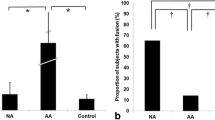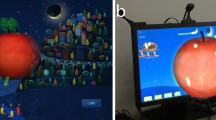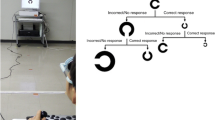Abstract
Purpose
To characterize changes in distant stereoacuity using Frisby–Davis Distance test (FD2) and Distant Randot test (DR) during treatment for anisometropic amblyopia, to determine factors that influence posttreatment stereoacuity and to compare the two distant stereotests.
Methods
Fifty-eight anisometropic amblyopic patients with an interocular difference of ≥1.00 diopter who achieved the visual acuity 20/20 following amblyopia treatment were retrospectively included. Stereoacuity using FD2 and DR for distant and Titmus test for near measurement were assessed and compared at the initial, intermediate, and final visit. Multivariate regression models were used to identify factors associated with initial and final stereoacuity.
Results
The two distant stereotests revealed a significant improvement in distant stereoacuity after successful amblyopia treatment. Distant stereoacuity using FD2 showed the greatest improvement during the follow up period. The number of nil scores was higher in DR than FD2 at each period. In multivariate analysis, better final stereoacuity was associated with better initial amblyopic eye acuity in both distant stereotests, but not in the Titmus test. Comparing the two distant stereotests, final stereoacuity using FD2 was associated with initial stereoacuity and was moderately related with the Titmus test at each period, but final stereoacuity using DR was not.
Conclusions
Distant stereoacuity measured with both FD2 and DR showed significant improvement when the visual acuity of the amblyopic eye achieved 20/20. Changes in distant stereoacuity by FD2 and DR during the amblyopia treatment were somewhat different.


Similar content being viewed by others
References
Preslan MW, Novak A. Baltimore vision screening project. Ophthalmology. 1996;103:105–9.
Rahi J, Logan S, Timms C, Russell-Eggitt I, Taylor D. Risk, causes, and outcomes of visual impairment after loss of vision in the non-amblyopic eye: a population-based study. Lancet. 2002;360:597–602.
Simons K. Amblyopia characterization, treatment, and prophylaxis. Surv Ophthalmol. 2005;50:123–66.
Multi-ethnic Pediatric Eye Disease Study Group. Prevalence of amblyopia and strabismus in African American and Hispanic children ages 6 to 72 months the multi-ethnic pediatric eye disease study. Ophthalmology. 2008;115(1229–36):e1.
Friedman DS, Repka MX, Katz J, Giordano L, Ibironke J, Hawse P, et al. Prevalence of amblyopia and strabismus in white and African American children aged 6 through 71 months the Baltimore Pediatric Eye Disease Study. Ophthalmology. 2009;116(2128–34):e1–2.
Schmidt P, Maguire M, Dobson V, Quinn G, Ciner E, Cyert L, et al. Comparison of preschool vision screening tests as administered by licensed eye care professionals in the Vision In Preschoolers Study. Ophthalmology. 2004;111:637–50.
Von Noorden GK. Factors involved in the production of amblyopia. Br J Ophthalmol. 1974;58:158–64.
Weakley DR Jr. The association between nonstrabismic anisometropia, amblyopia, and subnormal binocularity. Ophthalmology. 2001;108:163–71.
Pediatric Eye Disease Investigator Group. The clinical profile of moderate amblyopia in children younger than 7 years. Arch Ophthalmol. 2002;120:281–7.
Weakley DR. The association between anisometropia, amblyopia, and binocularity in the absence of strabismus. Trans Am Ophthalmol Soc. 1999;97:987–1021.
Shroff AP, Billore OP, Dubey AK, Antani PR. A combined approach by spectacle correction, occlusion and active pleoptic treatment in management of amblyopia. Indian J Ophthalmol. 1983;31:568–9.
Cotter SA, Edwards AR, Wallace DK, Beck RW, Arnold RW, Astle WF, et al. Treatment of anisometropic amblyopia in children with refractive correction. Ophthalmology. 2006;113:895–903.
Su L, Yan H, Xing Y, Zhang Y, Zhu B. Evaluation of occlusion treatment outcomes for unilateral amblyopia using different definitions of outcome. Semin Ophthalmol. 2014;. doi:10.3109/08820538.2014.962158.
Beardsell R, Clarke S, Hill M. Outcome of occlusion treatment for amblyopia. J Pediatr Ophthalmol Strabismus. 1999;36:19–24.
Wallace DK, Lazar EL, Melia M, Birch EE, Holmes JM, Hopkins KB, et al. Stereoacuity in children with anisometropic amblyopia. J AAPOS. 2011;15:455–61.
Caputo R, Frosini R, De Libero C, Campa L, Magro EF, Secci J. Factors influencing severity of and recovery from anisometropic amblyopia. Strabismus. 2007;15:209–14.
Lee SY, Isenberg SJ. The relationship between stereopsis and visual acuity after occlusion therapy for amblyopia. Ophthalmology. 2003;110:2088–92.
Holmes JM, Fawcett SL. Testing distance stereoacuity with the Frisby–Davis 2 (FD2) test. Am J Ophthalmol. 2005;139:193–5.
Holmes JM, Birch EE, Leske DA, Fu VL, Mohney BG. New tests of distance stereoacuity and their role in evaluating intermittent exotropia. Ophthalmology. 2007;114:1215–20.
Leske DA, Birch EE, Holmes JM. Real depth vs randot stereotests. Am J Ophthalmol. 2006;142:699–701.
Adams WE, Leske DA, Hatt SR, Holmes JM. Defining real change in measures of stereoacuity. Ophthalmology. 2009;116:281–5.
Wong BP, Woods RL, Peli E. Stereoacuity at distance and near. Optom Vis Sci. 2002;79:771–8.
von Gunter K, Noorden MD, Emilio C, Campos MD. Binocular vision and ocular motility theory and management of Strabismus. Mosby Inc., sixth edition 2002; 631 pages, 315 illustrations. Am Orthopt J. 2002;2001(51):161–2.
Lam AK, Chau AS, Lam WY, Leung GY, Man BS. Effect of naturally occurring visual acuity differences between two eyes in stereoacuity. Ophthalmic Physiol Opt. 1996;16:189–95.
Author information
Authors and Affiliations
Corresponding author
Ethics declarations
Conflicts of interest
Y. W. Chung, None; S. H. Park, None; S. Y. Shin, None.
About this article
Cite this article
Chung, Y.W., Park, S.H. & Shin, S.Y. Distant stereoacuity in children with anisometropic amblyopia. Jpn J Ophthalmol 61, 402–407 (2017). https://doi.org/10.1007/s10384-017-0518-9
Received:
Accepted:
Published:
Issue Date:
DOI: https://doi.org/10.1007/s10384-017-0518-9




